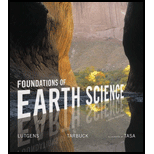
Whether a wintertime mP air mass or a wintertime cP air mass is likely to be colder and whether a summertime cT air mass or a summertime mT air mass should be warmer.
Answer to Problem 1GST
Since the land cools down at a faster rate and becomes colder than water, the continental polar air masses will be colder compared to the maritime polar air masses. Likewise, since the land gets heated more rapidly than the ocean, continental tropical air might be warmer relative to maritime tropical air.
Explanation of Solution
The air masses that have high latitudes towards the poles of the Earth as its source region are designated as polar (P) air masses, while those that originate in low latitudes are termed as tropical (T) air masses. When polar specifies cold, tropical designates warm.
The specific heat capacity of water is more compared to the land. This means that land absorbs and loses heat much rapidly and easily than ocean. As a result, the land cools and warms up faster compared to the oceans.
The faster cooling of land is the reason why the continental polar air masses are expected to be colder compared to the maritime polar air masses. While the dry air cools faster, the humid air is capable of generating heat by condensation.
Likewise, the faster warming up of the land is the reason for the continental tropical air masses to be warmer relative to maritime tropical air. The maritime tropical air mass holds the temperature-regulating effects of cool ocean water so as to avoid becoming hotter like the continental air masses.
Want to see more full solutions like this?
Chapter 14 Solutions
Foundations of Earth Science (8th Edition)
- Make the answer be 2.0 without changing the question. Explain each step and why the answer is 2.0arrow_forward8. The halocline (halo = salt, cline = slope) is a layer of ocean water where there is a rapid change in salin-ity with depth. Label the halocline on Figure 11.9.arrow_forward1. After examining the map and stereogram, draw a line on the map to outline the area illustrated on the stereogram. 2. What evidence on the map indicates that portions of the area are poorly drained? On what part of the map are these features located? 3. Use Figure 9.11 to draw a topographic profile of the X-Y line on Figure 9.10. 4. Is the general topography of the land in Sections 7 and 8 in the northwest portion of the region higher or lower in elevation than the land around the letter A located near the center of the map? Is it more or less hilly? 5. Is the area that coincides with Kettle Moraine State Forest higher or lower in elevation than the land to the northwest and southeast? 6. The feature labeled A on the map is a long ridge composed of till. Is this ridge an esker, an end moraine, or a drumlin?arrow_forward
- 5. Use Figure 9.14 to draw a topographic profile along the X-Y line from Sugar Loaf Mountain to Bear Lake and mark the position of the Lake Fork stream. (Use only index contours.) 6. Describe the shape of Lake Fork Valley, based on your profile. 7. What glacial feature is Lake Fork Valley?arrow_forward7. The streamlined, asymmetrical hills composed of till, labeled B, are what type of feature? 8. Examine the shape of the features labeled B on the map in Figure 9.10. How can these features be used to determine the direction of ice flow in a glaciated area? 9. Using the features labeled B in Figure 9.10 as a guide, draw an arrow on the map to indicate the direction of ice movement that occurred in this region. 10. What is the likely location of the outwash plain on the map? Identify and label the area "outwash plain." (Hint: Refer to Figure 9.7.) 11. Label the area covered by ground moraine. 12. What term is applied to the numerous almost circular depressions designated with the letter C?arrow_forwardRabbit population over time which letter(A,B,or C) shows a growth period for the rabbit populationarrow_forward
 Applications and Investigations in Earth Science ...Earth ScienceISBN:9780134746241Author:Edward J. Tarbuck, Frederick K. Lutgens, Dennis G. TasaPublisher:PEARSON
Applications and Investigations in Earth Science ...Earth ScienceISBN:9780134746241Author:Edward J. Tarbuck, Frederick K. Lutgens, Dennis G. TasaPublisher:PEARSON Exercises for Weather & Climate (9th Edition)Earth ScienceISBN:9780134041360Author:Greg CarbonePublisher:PEARSON
Exercises for Weather & Climate (9th Edition)Earth ScienceISBN:9780134041360Author:Greg CarbonePublisher:PEARSON Environmental ScienceEarth ScienceISBN:9781260153125Author:William P Cunningham Prof., Mary Ann Cunningham ProfessorPublisher:McGraw-Hill Education
Environmental ScienceEarth ScienceISBN:9781260153125Author:William P Cunningham Prof., Mary Ann Cunningham ProfessorPublisher:McGraw-Hill Education Earth Science (15th Edition)Earth ScienceISBN:9780134543536Author:Edward J. Tarbuck, Frederick K. Lutgens, Dennis G. TasaPublisher:PEARSON
Earth Science (15th Edition)Earth ScienceISBN:9780134543536Author:Edward J. Tarbuck, Frederick K. Lutgens, Dennis G. TasaPublisher:PEARSON Environmental Science (MindTap Course List)Earth ScienceISBN:9781337569613Author:G. Tyler Miller, Scott SpoolmanPublisher:Cengage Learning
Environmental Science (MindTap Course List)Earth ScienceISBN:9781337569613Author:G. Tyler Miller, Scott SpoolmanPublisher:Cengage Learning Physical GeologyEarth ScienceISBN:9781259916823Author:Plummer, Charles C., CARLSON, Diane H., Hammersley, LisaPublisher:Mcgraw-hill Education,
Physical GeologyEarth ScienceISBN:9781259916823Author:Plummer, Charles C., CARLSON, Diane H., Hammersley, LisaPublisher:Mcgraw-hill Education,





